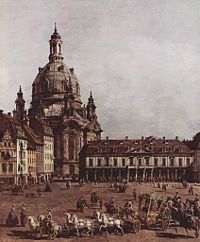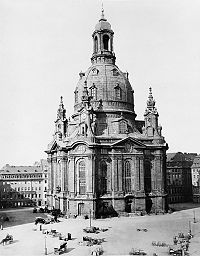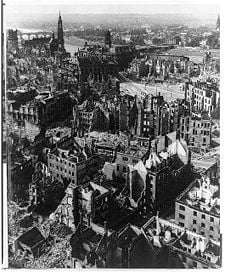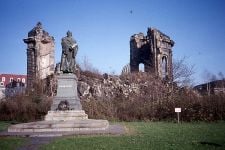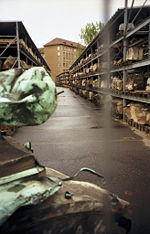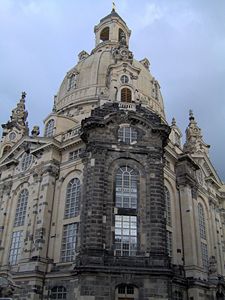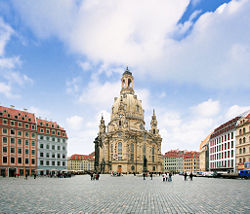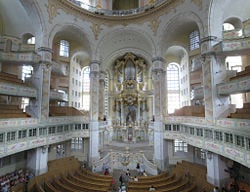Dresden Frauenkirche
| Dresden Frauenkirche | |
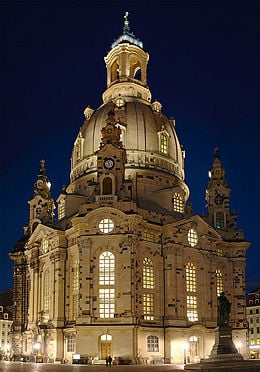
Dresden Frauenkirche at night | |
| Basic information | |
|---|---|
| Location | Dresden, Germany |
| Geographic coordinates | Coordinates: |
| Religious affiliation | Lutheran Church |
| Website | Frauenkirche Dresden |
| Architectural description | |
| Architect/s | George Bähr |
| Architectural type | German Baroque |
| Specifications | |
| Capacity | 1,818 |
| Height (max) | 91,23 m |
| Dome dia. (outer) | 26,15 m |
The Dresdner Frauenkirche ("Church of Our Lady") is a Lutheran Church in Dresden, Germany. The Dresden Frauenkirche survived the firebombing of Dresden during World War II, but collapsed the following day due to the effects of fire. Dresden's residents organized and cataloged stones from among the ruins, beginning soon after its destruction. While intention to rebuild the church began during the last months of World War II, its reconstruction was delayed due to political circumstances in the German Democratic Republic throughout the years of Communist rule.
Reconstruction commenced in January 1993, under the direction of church architect and engineer Eberhard Burger, using the original eighteenth century plans. Approximately 3,800 stones from the original building were reused in the reconstruction. The foundation stone was re-laid in 1994, the crypt was completed in 1996, and the inner cupola in 2000. The reconstruction of the church's exterior was completed in 2004, its interior in 2005. After nearly 13 years of rebuilding, the church was reconsecrated on October 30, 2005, with festive services lasting throughout the Protestant observance of Reformation Day on October 31.
The rebuilt church is considered a landmark symbol of reconciliation between former warring enemies, and illustrates the possibility of rebirth.
Name
The name Frauenkirche is commonly used in about 40 cities throughout Germany, including Meißen, Munich, Nuremberg, and Bremen. They can also be found in other European countries such as Belgium or France, where they are called Notre Dame, or Our Lady, and refer to Mary, the mother of Jesus. A Frauenkirche is a church that has been or is consecrated in honor of the Virgin Mary.
The original name of the Dresden Frauenkirche was "Unserer Lieben Frauen," which dates back to the time the church was founded in the early-mid 1700s. The name was shortened over time to ‘Frauenkirche’ and even retained after the Reformation despite the fact that the Protestant Church displays no adoration of the Virgin Mary.[1]
History
A requirement for the throne of the Polish-Lithuanian Commonwealth was membership in the Roman Catholic church. Thus Frederick August I (1670-1733) converted. Saxon dukes had traditionally been called "champions of the Reformation." The duchy was a stronghold of German Protestantism and therefore, Augustus's conversion was spectacular and not without controversy. The Roman Catholic electors of Saxony lost the prestigious leading role of the Protestant estates in the Imperial Diet to Brandenburg-Prussia. Since the prince-elector guaranteed Saxony's religious status quo, Augustus's conversion alienated some of his Protestant subjects. This explains how the Catholic Prince-elector of Saxony, Frederick August I, could build a magnificent Lutheran church as a monument to Protestant beliefs, in spite of being Catholic.
The original baroque church was built between 1726 and 1743, and was designed by Dresden's city architect George Bähr (1666–1738), one of the greatest masters of German Baroque style, who did not live to see the completion of his greatest work. Bähr's distinctive design for the church captured the new spirit of the Protestant liturgy by placing the altar, pulpit, and baptismal font directly centered in view of the entire congregation.
In 1736, famed organ maker Gottfried Silbermann (1683–1753) built a three-manual, 43-stop instrument for the church. The organ was dedicated on November 25th, and Johann Sebastian Bach (1685–1750) gave a recital on the instrument on December 1st.
The church's most distinctive feature was its unconventional 314-foot (96 m)-high dome, called die Steinerne Glocke or "Stone Bell." An engineering triumph comparable to Michelangelo's dome for St. Peter's Basilica in Rome, the Frauenkirche's 12,000-ton sandstone dome soared skyward with no internal supports. Despite initial doubts, the dome proved to be extremely stable. Witnesses in 1760 said that the dome had been hit by more than 100 cannonballs fired by the Prussian army led by Friedrich II during the Seven Years' War. The projectiles simply bounced off and the church survived.
The completed church gave the city of Dresden a distinctive silhouette, captured in famous paintings by Bernado Bellotto, a nephew to the artist Canaletto, and the Dresden by moonlight by Norwegian painter Johan Christian Dahl.
In 1849, the church was at the heart of the revolutionary disturbances known as the May Uprising. The Frauenkirche was surrounded by barricades, and fierce fighting raged for days before those rebels who had not already fled were rounded up in the church and arrested.
For more than 200 years, the magnificent bell-shaped dome stood monumentally and gracefully over the skyline of old Dresden, dominating the city.
Destruction
During World War II (1939-1945), Dresden was attacked seven times between 1944 and 1945. The bombing of Dresden by the Royal Air Force and by the United States Air Force between February 13 and February 15, 1945, remains one of the more controversial Allied actions. While the inhabited city center was wiped out, larger residential, industrial and military sites on the outskirts were relatively unscathed by the bombing and subsequent fire storm. None of Dresden's garrisons or military sites were targeted.
The church impressively survived two days and nights of the attacks and the eight interior sandstone pillars supporting the colossal dome held up long enough for the evacuation of 300 people who had sought shelter in the church crypt, before succumbing to the heat generated by the incendiary bombs that were dropped on the city. The temperature of the masonry reached an estimated 1,000°C (1832°F).[2]
The dome finally collapsed at 10 a.m. on February 15th. The pillars glowed bright red and exploded; the outer walls shattered and nearly 6,000 tons of stone plunged to earth, penetrating the massive floor as it fell.
The altar, a relief depiction of Jesus’ agony in the Garden of Gethsemane on the Mount of Olives by Johann Christian Feige, was only partially damaged during the bombing raid and fire that destroyed the church. The altar and the structure behind it, the chancel, were among the remnants left standing. Features of most of the figures were lopped off by falling debris and the fragments lay under the rubble.
The building vanished from Dresden's skyline, and the blackened stones lay buried in a pile in the center of the city for the next 45 years as Communist rule enveloped what was now East Germany. Shortly after the end of World War II, residents of Dresden had begun salvaging unique stone fragments from the Frauenkirche and numbering them for future use in reconstruction. Popular sentiment discouraged the authorities from clearing the ruins away to construct a proposed car park.
In 1982, the ruins began to be the site of a peace movement combined with popular peaceful protests against the East German regime. On the anniversary of the bombing, 400 Dresdeners came to the ruins in silence with flowers and candles, part of a growing East German civil rights movement. By 1989, the number of protesters in Dresden, Leipzig and other parts of East Germany had increased to tens of thousands, and the wall dividing East and West Germany toppled. This opened the way to the reunification of Germany.
Promoting reconstruction and funding
Intentions to rebuild the church began during the last months of World War II. However, due to political circumstances in the German Democratic Republic, the reconstruction was put on hold. The heap of ruins was conserved as a war memorial within the inner city of Dresden, as a direct counterpart to the ruins of Coventry Cathedral, which was destroyed by German bombing in 1940 and also serves as a war memorial in England. Because of the continuing decay of the ruins, Dresden decided in 1985 to rebuild the Frauenkirche, after the completion of the reconstruction of the Dresden Castle.
After the reunification of Germany, efforts were revived. In 1989, a 14-member group of enthusiasts headed by Ludwig Güttler, a noted Dresden musician, formed a Citizens' Initiative. From that group emerged a year later "The Society to Promote the Reconstruction of the Frauenkirche," which began an aggressive private fund-raising campaign. The organization grew to over 5,000 members in Germany and 20 other countries. A string of German auxiliary groups were formed, and three promotional organizations were created abroad.
The project gathered momentum. As hundreds of architects, art historians, and engineers sorted the thousands of stones, identifying and labeling each for reuse in the new structure. Others worked to raise money.
Günter Blobel, a German-born American, saw the original Frauenkirche as a child when his refugee family took shelter in a town just outside of Dresden days before the city was bombed. In 1994, he became the founder and president of the nonprofit "Friends of Dresden, Inc.," a United States organization dedicated to supporting the reconstruction, restoration and preservation of Dresden's artistic and architectural legacy. In 1999, Blobel won the Nobel Prize for medicine and donated the entire amount of his award money (nearly US$1 million) to the organization for the restoration of Dresden, to the rebuilding of the Frauenkirche and the building of a new synagogue. It was the single largest individual donation to the project.
In Britain, the Dresden Trust has the Duke of Kent as its royal patron and the Bishop of Coventry among its curators. Dr. Paul Oestreicher, a canon emeritus of Coventry Cathedral and a founder of the Dresden Trust, wrote "The church is to Dresden what St. Paul's [Cathedral] is to London."[3] Additional organizations include France's Association Frauenkirche Paris, and Switzerland's Verein Schweizer Freunde der Frauenkirch, among others.
Rebuilding the Frauenkirche cost €180 million (£122 million / US$217 million). Dresdner Bank financed more than half of the reconstruction costs via a "donor certificates campaign," collecting almost €70 million after 1995. The bank itself contributed more than seven million euros, including more than one million donated by its employees. Over the years, thousands of watches containing tiny fragments of Frauenkirche stone were sold, as were specially printed medals. One sponsor raised nearly €2.3 million (US$2.75 million) through symbolic sales of individual church stones.
Funds raised were turned over to the "Frauenkirche Foundation Dresden," the actual rebuilder, backed by the State of Saxony, the city of Dresden, and the Evangelical Lutheran Church of Saxony.
Reconstruction
Using the original 1720s plans used by builder Georg Bähr, reconstruction finally began in January 1993, under the direction of church architect and engineer Eberhard Burger. The foundation stone was laid in 1994, the crypt was completed in 1996, and the inner cupola in 2000.
As far as possible, the church—except for its dome—was rebuilt using original material and plans, with the help of modern technology. The heap of rubble was documented and carried off stone by stone. The approximate original position of each stone could be determined from its position in the heap. Every usable piece was measured and cataloged. A computer imaging program that could move the stones three-dimensionally around the screen in various configurations was used to help architects find where the original stones sat and how they fit together.
Of the millions of stones used in the rebuilding, more than 8,500 original stones were salvaged from the original church and approximately 3,800 reused in the reconstruction. As the older stones are covered with a darker patina due to fire damage and weathering, the difference between old and new stones will be clearly visible for a number of years after reconstruction.
Two thousand pieces of the original altar were cleaned and incorporated into the new structure.
The builders relied on thousands of old photographs, memories of worshippers, and church officials and crumbling old purchase orders detailing the quality of the mortar or pigments of the paint. As in the eighteenth century, copious quantities of eggs were used to make the color that provides the interior its almost luminescent glow.
When it came time to duplicate the oak doors of the entrance, the builders had only vague descriptions of the detailed carving. Because people, especially wedding parties, often posed for photos outside the church doors, they issued an appeal for old photographs and the response—which included entire wedding albums—allowed artisans to recreate the original doors.
The new gilded orb and cross on top of the dome was forged by Grant Macdonald Silversmiths in London using the original eighteenth century techniques as much as possible. It was constructed by Alan Smith, a British goldsmith from London whose father, Frank, was a member of one of the aircrews who took part in the bombing of Dresden.[4] Before traveling to Dresden, the cross was exhibited for five years in churches across the United Kingdom, including Coventry Cathedral, Liverpool Cathedral, St Giles Cathedral in Edinburgh and St. Paul's Cathedral in London. In February 2000, the cross was ceremonially handed over by The Duke of Kent,[2] to be placed on the top of the dome a few days after the 60th commemoration of D-Day on June 22, 2004.[5] The external structure of the Frauenkirche was completed. For the first time since the war, the completed dome and its gilded cross grace Dresden's skyline as in centuries prior. The cross that once topped the dome, now twisted and charred, stands to the right of the new altar.
Seven new bells were cast for the church. They rang for the first time for the Pentecost celebration in 2003.
The decision was made not to reproduce a replica of the Silbermann organ. The decision resulted in the Dresden organ dispute ("Dresdner Orgelstreit"), that was partially based on the misunderstanding that the new organ would be entirely "modern." A 4,873 pipe organ was built by Daniel Kern of Strasbourg, France, and completed in April 2005. The Kern organ contains all the stops which were on the stoplist of the Silbermann organ and tries to reconstruct them. Additional stops also are included, especially a fourth swell manual in the symphonic nineteenth century style which is apt for the organ literature composed after the baroque period.
A bronze statue of reformer and theologian Martin Luther, which survived the bombings, has been restored and again stands in front of the church. It is the work of sculptor Adolf von Donndorf from 1885.
The intensive efforts to rebuild this world famous landmark were completed in 2005, one year earlier than originally planned, and in time for the 800-year anniversary of the city of Dresden in 2006. The church was reconsecrated with a festive service one day before Reformation Day.
Post reconstruction
Since its re-opening, the Frauenkirche has been a hugely popular tourist destination. The project prompted reconstruction of other buildings in the city—Dresden is recovering its old town center with a pioneering mixture of tradition and modern. It has also inspired other revitalization projects throughout Europe.
The use of the building’s original substance to as large an extent as possible—and the visible difference between the old and the new—is viewed as symbolism of the resurrection of that which appeared to be destroyed. The dark coloring of the old stones and the dimensional differences in the joint areas between the new and old masonry is said to resemble the scars of healed wounds. In this way, the Frauenkirche serves as a reminder of past destruction, and also as a testimony to the overcoming of enmity and a sign of hope and reconciliation.
See also
Notes
- ↑ Frauenkirche Dresden, History. Retrieved January 16, 2009.
- ↑ 2.0 2.1 BBC News, February 13, 2000, Duke leads Dresden tribute. Retrieved January 16, 2009.
- ↑ Luke Harding, October 31, 2005, Cathedral hit by RAF is rebuilt, Guardian News and Media Limited. Retrieved January 17, 2009.
- ↑ BBC News, December 1, 1998, Dresden Cross presented at Windsor. Retrieved January 17, 2009.
- ↑ Ray Furlong, June, 2004, Dresden ruins finally restored, BBC NEWS. Retrieved January 17, 2009.
ReferencesISBN links support NWE through referral fees
- Magirius, Heinrich, Margaret Marks, and Heinrich Magirius. The Frauenkirche Dresden. Kunstführer, Nr. 2384. Regensburg: Schnell und Steiner, 2005. ISBN 978-3795465940
- Zumpe, Dieter, and Rainer Dohrmann. The Dresden Frauenkirche the Historical Building, the Destruction, the Reconstruction. Lübeck: Schöning, 2007. ISBN 3899171993
Credits
New World Encyclopedia writers and editors rewrote and completed the Wikipedia article in accordance with New World Encyclopedia standards. This article abides by terms of the Creative Commons CC-by-sa 3.0 License (CC-by-sa), which may be used and disseminated with proper attribution. Credit is due under the terms of this license that can reference both the New World Encyclopedia contributors and the selfless volunteer contributors of the Wikimedia Foundation. To cite this article click here for a list of acceptable citing formats.The history of earlier contributions by wikipedians is accessible to researchers here:
The history of this article since it was imported to New World Encyclopedia:
Note: Some restrictions may apply to use of individual images which are separately licensed.
